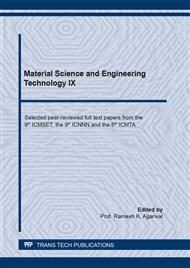[1]
H. Luo et al., Ultra-high discharged energy density capacitor using high aspect ratio Na 0.5 Bi 0.5 TiO3 nanofibers,, Journal of Materials Chemistry A, vol. 5, no. 15, pp.7091-7102, (2017).
DOI: 10.1039/c7ta00136c
Google Scholar
[2]
H. Kim, J. Johnson, L. A. Chavez, C. A. G. Rosales, T.-L. B. Tseng, and Y. Lin, Enhanced dielectric properties of three phase dielectric MWCNTs/BaTiO3/PVDF nanocomposites for energy storage using fused deposition modeling 3D printing,, Ceramics International, vol. 44, no. 8, pp.9037-9044, (2018).
DOI: 10.1016/j.ceramint.2018.02.107
Google Scholar
[3]
L. He, J. Wang, Z. Yang, K. Zhu, and C. Deng, Dielectric and energy storage properties of PVDF/Nd-BaTiO3@ Al2O3 composite films,, Functional Materials Letters, vol. 12, no. 03, p.1950034, (2019).
DOI: 10.1142/s1793604719500346
Google Scholar
[4]
Prateek, R. Bhunia, S. Siddiqui, A. Garg, and R. K. Gupta, Significantly Enhanced Energy Density by Tailoring the Interface in Hierarchically Structured TiO2–BaTiO3–TiO2 Nanofillers in PVDF-Based Thin-Film Polymer Nanocomposites,, ACS applied materials & interfaces, vol. 11, no. 15, pp.14329-14339, (2019).
DOI: 10.1021/acsami.9b01359
Google Scholar
[5]
Z. Sun, L. Yang, S. Liu, J. Zhao, Z. Hu, and W. Song, A Green Triboelectric Nano-Generator Composite of Degradable Cellulose, Piezoelectric Polymers of PVDF/PA6, and Nanoparticles of BaTiO3,, Sensors, vol. 20, no. 2, p.506, (2020).
DOI: 10.3390/s20020506
Google Scholar
[6]
P. Hu, S. Gao, Y. Zhang, L. Zhang, and C. Wang, Surface modified BaTiO3 nanoparticles by titanate coupling agent induce significantly enhanced breakdown strength and larger energy density in PVDF nanocomposite,, Composites Science and Technology, vol. 156, pp.109-116, (2018).
DOI: 10.1016/j.compscitech.2017.12.025
Google Scholar
[7]
M. A. Osman, J. E. Rupp, and U. W. Suter, Tensile properties of polyethylene-layered silicate nanocomposites,, Polymer, vol. 46, no. 5, pp.1653-1660, (2005).
DOI: 10.1016/j.polymer.2004.11.112
Google Scholar
[8]
M. Bi, Y. Hao, J. Zhang, M. Lei, and K. Bi, Particle size effect of BaTiO3 nanofillers on the energy storage performance of polymer nanocomposites,, Nanoscale, vol. 9, no. 42, pp.16386-16395, (2017).
DOI: 10.1039/c7nr05212j
Google Scholar
[9]
H. Luo et al., Core–Shell Nanostructure Design in Polymer Nanocomposite Capacitors for Energy Storage Applications,, ACS Sustainable Chemistry & Engineering, vol. 7, no. 3, pp.3145-3153, (2018).
DOI: 10.1021/acssuschemeng.8b04943
Google Scholar
[10]
Z. Cai, X. Wang, B. Luo, W. Hong, L. Wu, and L. Li, Dielectric response and breakdown behavior of polymer-ceramic nanocomposites: The effect of nanoparticle distribution,, Composites Science and Technology, vol. 145, pp.105-113, (2017).
DOI: 10.1016/j.compscitech.2017.03.039
Google Scholar
[11]
B. Zazoum, Optimization of dielectric strength of polymer/TiO2 nanocomposites for high voltage insulation,, Materials Research Express, vol. 6, no. 11, p. 1150g8, (2019).
DOI: 10.1088/2053-1591/ab519d
Google Scholar
[12]
B. Zazoum, Experimental and Modeling Studies of 2D Clay/PE Nanocomposites for High Voltage Applications,, ECS Journal of Solid State Science and Technology, vol. 9, no. 9, p.093002, (2020).
DOI: 10.1149/2162-8777/ab85bf
Google Scholar
[13]
M. H. Esfe, M. Afrand, W.-M. Yan, and M. Akbari, Applicability of artificial neural network and nonlinear regression to predict thermal conductivity modeling of Al2O3–water nanofluids using experimental data,, International Communications in Heat and Mass Transfer, vol. 66, pp.246-249, (2015).
DOI: 10.1016/j.icheatmasstransfer.2015.06.002
Google Scholar
[14]
M. H. Ahmadi, A. Mirlohi, M. A. Nazari, and R. Ghasempour, A review of thermal conductivity of various nanofluids,, Journal of Molecular Liquids, vol. 265, pp.181-188, (2018).
DOI: 10.1016/j.molliq.2018.05.124
Google Scholar
[15]
S. Naskar, T. Mukhopadhya, and S. Sriramula, A comparative assessment of ANN and PNN model for low-frequency stochastic free vibration analysis of composite plates,, in Handbook of Probabilistic Models: Elsevier, 2020, pp.527-547.
DOI: 10.1016/b978-0-12-816514-0.00022-9
Google Scholar
[16]
A. Solati, M. Hamedi, and M. Safarabadi, Combined GA-ANN approach for prediction of HAZ and bearing strength in laser drilling of GFRP composite,, Optics & Laser Technology, vol. 113, pp.104-115, (2019).
DOI: 10.1016/j.optlastec.2018.12.016
Google Scholar
[17]
T. P. Vogl, J. Mangis, A. Rigler, W. Zink, and D. Alkon, Accelerating the convergence of the back-propagation method,, Biological cybernetics, vol. 59, no. 4-5, pp.257-263, (1988).
DOI: 10.1007/bf00332914
Google Scholar
[18]
R. Rojas, Neural Networks-A Systematic Introduction Springer-Verlag,, New York, (1996).
Google Scholar
[19]
W. Wang, S. Li, and S. Yu, Dielectric response characteristics of low density polyethylene/TiO2 nanocomposites,, in 2013 Annual Report Conference on Electrical Insulation and Dielectric Phenomena, 2013: IEEE, pp.726-729.
DOI: 10.1109/ceidp.2013.6748311
Google Scholar
[20]
D. W. Marquardt, An algorithm for least-squares estimation of nonlinear parameters,, Journal of the society for Industrial and Applied Mathematics, vol. 11, no. 2, pp.431-441, (1963).
DOI: 10.1137/0111030
Google Scholar


